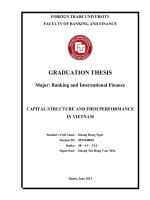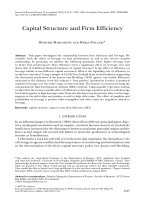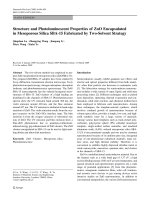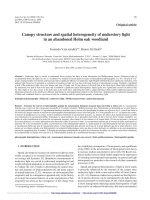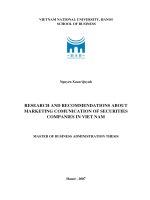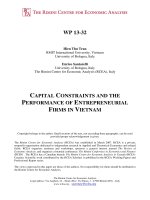Capital structure and firm performance of listed companies in vietnam
Bạn đang xem bản rút gọn của tài liệu. Xem và tải ngay bản đầy đủ của tài liệu tại đây (3.09 MB, 107 trang )
CAPITAL STRUCTURE AND FIRM PERFORMANCE OF LISTED COMPANIES
IN VIETNAM
In Partial Fulfillment of the Requirements of the Degree of
MASTER OF BUSINESS ADMINISTRATION
In Finance
By
Ms: Nguyen Thi Van Anh
ID: MBA04050
International University - Vietnam National University HCMC
September 2013
CAPITAL STRUCTURE AND FIRM PERFORMANCE OF LISTED COMPANIES
IN VIETNAM
In Partial Fulfillment of the Requirements of the Degree of
MASTER OF BUSINESS ADMINISTRATION
In Fianance
by
Ms: Nguyen Thi Van Anh
ID: MBA04050
International University - Vietnam National University HCMC
September 2013
Under the guidance and approval of the committee, and approved by all its members, this
thesis has been accepted in partial fulfillment of the requirements for the degree.
Approved:
---------------------------------------------Chairperson
--------------------------------------------Advisor
---------------------------------------------Committee member
--------------------------------------------Committee member
---------------------------------------------Committee member
--------------------------------------------Committee member
Acknowledge
This thesis report is about the Capital Structure and Firm Performance would not have
been possible without valuable contribution of all teachers from School of Business.
I would like to thank to the International University, Vietnam National University –
Ho Chi Minh City for giving me a great opportunity to practice and learn more knowledge. I
especially appreciated the School of Business that helped us have good condition to do the
necessary research work and archive the results. I am deeply indebted to my thesis project
advisor Dr. Duong Nhu Hung, for his patience, guidance and advice throughout this semester.
He was always keeping his eyes on my research. This gave me the efforts which proved
valuable for the success of this thesis project. Moreover, my gratitude goes to my beloved
husband Mr. Nguyen Thanh Tung for his love, insightful guidance, assistance, and support
during the entire process of my mater‟s study and the writing of this dissertation.
Finally, I would like to thank my parents, also my friends for supporting and
encouraging me throughout my studies. With their love, I could finish this work.
I hope this will serve as a valuable resource for whose major or carrier related to this
field.
i
Plagiarism Statements
I would like to declare that, apart from the acknowledged references, this thesis either
does not use language, ideas, or other original material from anyone; or has not been
previously submitted to any other educational and research programs or institutions. I fully
understand that any writings in this thesis contradicted to the above statement will
automatically lead to the rejection from the MBA program at the International University –
Vietnam National University Hochiminh City.
ii
Copyright Statement
This copy of the thesis has been supplied on condition that anyone who consults it is
understood to recognize that its copyright rests with its author and that no quotation from the
thesis and no information derived from it may be published without the author‟s prior consent.
© Nguyen Thi Van Anh/ MBA04050/ 2011 - 2013
iii
Table of Contents
Chapter One - Introduction .................................................................................................... 1
1.1.
Background ................................................................................................................. 1
1.2.
Research objective....................................................................................................... 5
1.3.
Data and methodology ................................................................................................ 6
1.4.
Limitation .................................................................................................................... 6
1.5.
Structure of the study .................................................................................................. 6
Chapter Two - Literature Review .......................................................................................... 8
2.1.
Theories on capital structure ....................................................................................... 8
2.1.1.
The Miller and Modigliani Theory ...................................................................... 8
2.1.2.
Static Tradeoff Theory ......................................................................................... 9
2.1.3.
Agency Cost Theory .......................................................................................... 10
2.1.4.
Pecking Order Theory ........................................................................................ 12
2.2.
Previous studies on capital structure and firm performance ..................................... 13
2.2.1.
Internationally empirical findings ...................................................................... 13
2.2.2.
Empirical findings from Vietnamese perspective .............................................. 14
2.3.
Determinants of Capital Structure and Their Hypothesis ......................................... 16
2.3.1.
Dependent Variables .......................................................................................... 16
2.3.2.
Independent Variables ....................................................................................... 16
Chapter Three – Data and Methodology ............................................................................. 24
3.1.
Data collection........................................................................................................... 24
3.2.
Data Analysis Method ............................................................................................... 24
iv
Chapter Four - Empirical Result.......................................................................................... 28
4.1.
Descriptive Statistics ................................................................................................. 28
4.2.
Multi – collineartity................................................................................................... 32
4.3.
Regression results and discussions ............................................................................ 35
4.3.1.
Profitability Firm Performance .......................................................................... 37
4.3.2.
Size..................................................................................................................... 39
4.3.3.
Tangible assets ................................................................................................... 40
4.3.4.
Growth opportunity............................................................................................ 40
4.3.5.
Inflation rate ....................................................................................................... 41
4.3.6.
Asset specificity ................................................................................................. 41
4.3.7.
Parent companies and Their Affiliated Companies ........................................... 42
Chapter Five – Conclusions and Recommendations .......................................................... 45
References ............................................................................................................................... 49
Appendix 1 ........................................................................................................................A1 - 1
Appendix 2 ........................................................................................................................A2 - 1
Appendix 3 ........................................................................................................................A3 - 1
Appendix 4 ........................................................................................................................A4 - 1
Appendix 5 ........................................................................................................................A5 - 1
Appendix 6 ........................................................................................................................A6 - 1
Appendix 7 ........................................................................................................................A7 - 1
Appendix 8 ........................................................................................................................A8 - 1
v
List of Tables
Table 1: Summary the findings of the previous studies ........................................................... 15
Table 2: Summary of the implications of theories and all hypotheses of the study ................ 23
Table 3: Description of Variables ............................................................................................ 26
Table 4: Descriptive statistics of Variables ............................................................................. 29
Table 5: Correlation matrix ...................................................................................................... 33
Table 6: Estimation Results for Panel Data Models Using ROA ............................................ 35
Table 7: Estimation Results for Panel Data Models Using ROE............................................. 36
Table 8: Estimation Results for Panel Data Models Using TOBINQ ..................................... 36
Table 9: Regression Result of Capital Structure ...................................................................... 42
Table 10: Regression Result of Firm Performance .................................................................. 43
vi
Abstract
Capital structure decisions have been the most significant decisions to be taken by any
business organization for maximization of shareholders wealth and sustained growth. The
study examines the relationship between capital structure and firm performance of 200 listed
firms on the HOSE for a period of five years from 2008 to 2012. This study employed panel
data analysis by using fixed-effect estimation. Empirical result shows that the listed firms on
the HOSE employ mostly short-term liabilities to finance their operations. According to the
results, all measures of firm performance are found to have a significant and negative impact
on all measures of firm capital structure. This result is contrary to the predictions of trade-off
theory but consistent with the pecking order theory. The result also reveals that firm size has
a positive and significant impact on the leverage, tangible asset is negative and significantly
related to STDTA and TDTA, growth opportunity variable has a negative and significant
coefficient with LTDTA and TDTA, the inflation rate has a negative effect on TDTE, the
coefficient of asset specificity is negative and significantly related to all measures of leverage
(except STDTA). There appears two interesting findings are that TDTA of the parent
companies has a negative impact on TDTA of their affiliated companies and two measures of
firm performance (ROA and ROE) of the parent companies have a significantly positive
impact on two measures of firm performance (ROA and ROE) of their affiliated companies.
Keywords: capital structure, firm performance, parent company, affiliated company, listed
firm, Ho Chi Minh Stock Exchange, panel data, fix-effect model.
vii
viii
Chapter One - Introduction
1.1.
Background
One of the most important reference theories in enterprises financing policy is the
theory of capital structure. The capital structure of an enterprise is the mix of debt
including preference stock and equity; this is referred to as the firms‟ long term
financing mix (Watson and Head, 2007). Capital structure decision is fundamental for
any business organization. This decision is important because the organizations need
to maximize return to various stake holders and it also has an effect on the value of
the firm. Besides that, the impact from the decision will help the firm‟s ability to deal
with its competitive environment. Capital structure decisions represent another pivotal
financial decision of a business organization apart from investment decisions. It is
important since it involves a huge amount of money and has long- term implications
on the firms. One crucial issue confronting managers today is how to choose the
combination of debt and equity to achieve optimum capital structure that would
minimize the firm‟s cost of capital and improves return to owners of the business.
Even though generally firms have a choice as to how to combine debt and equity,
managers attempt to ascertain a particular combination that will maximize
profitability and the firm‟s market value. The kind of combination of debt and equity
that will minimize the firms cost of capital and hence maximizes the firm‟s
profitability and market value is the optimal capital structure. Unfortunately, financial
managers do not have a clear cut guideline that they can consult when taking decision
in connection with optimal capital structure. The idea of modern theory of capital
structure is originated from the path breaking contribution of Modigliani and Miller
(1958) under the perfect capital market assumption. Modigliani and Miller (1958)
assumed that under condition of no bankruptcy cost and frictionless capital markets
1
without taxes, firm‟s value is independent of its capital structure. Modigliani and
Miller (1963) in considering of the existence of corporate taxes suggested that firms
should use as much debt capital as possible in order to maximize their value by
maximizing the interest tax shield.
Other theories that have been advanced to explain the capital structure of firms
include the static tradeoff theory, the agency cost theory, and pecking order theory.
Pecking order theory suggests that firms will initially rely on internally generated
funds, and then they will turn to debt if additional funds are needed and finally they
will issue equity to cover any remaining. Thus, according to the pecking order
hypothesis, firms that are profitable and therefore generate high earnings are expected
to use less debt capital than those who do not generate high earnings. Hence, internal
funds are used first, and when that is depleted, debt is issued, and when it is not
sensible to issue any more debt, equity is issued (Myers and Majluf, 1984).
Agency costs are the costs that arise from the principal-stakeholder relationship, such
as between shareholders or managers of the firm and debt-holders. Moreover, the
given incentives to the firm will benefit shareholders at the expense of debt-holders.
Thus, debt-holders need to restrict and monitor the firm‟s behaviour. Consequently,
costly monitoring devices of contractual covenants are incorporated into debt
agreements to protect the debt-holders. Hence, it should increase the cost of capital
offered to the firm. Therefore, firms with relatively higher agency costs due to
inherent conflicts between the firm and the debt-holders should have lower levels of
outside debt financing and leverage.
Furthermore, according to Gleason et al. (2000), the utilization of different levels of
debt and equity in the firm‟s capital structure is one such firm-specific strategy used
by managers in the search for improved performance. Hence, most firms have tried to
2
achieve an optimal capital structure in order to minimize the cost of capital or to
maximize the firm value, thereby improving its competitive advantage in the
marketplace through a mixture of debt and equity financing. Thus, selecting the right
type of debt is an equally important issue as opting for an appropriate debt to equity
ratio. However, as noted by Myer (2001), each theory works under its own
assumptions and propositions, hence, none of the theories can give a complete picture
of the practice of capital structure.
Ross (1977), Heinkel (1982) and Noe (1988) suggest that increasing leverage, by
acquiring debt should have positive implications for firm value and performance.
Furthermore, this result is also supported by Hadlock and James (2002) where they
concluded that companies prefer debt (loan) financing because they anticipate a
higher return. According to Champion (1999), the use of leverage is one way to
improve the performance of the firm.
Due to the lack of a consensus about what would qualify as optimal capital structure,
it is pertinent to examine the effect of debt utilization on firms‟ performance. Several
such studies were conducted in European countries and in the United States. They
found contradictory results when Gleason (2000) supported a negative impact of
leverage on the profitability of the firm while Roden and Lewellen (1995) found a
significant positive association between profitability and total debt as a percentage of
the total buyout-financing package in their study on leveraged buyouts. Thus, there is
no universal theory about debt-equity choices and have different views regarding the
financing option.
The contribution of these studies would help the manager of the companies to make
good decisions on the proportions of their capital structure. If they have taken too
much debt in the operations of the company, this can jeopardize the company‟s future,
3
thus can make the companies go bankrupt. Hence, this will provide and add new
knowledge to corporate managers as a benchmark in making their own decision on
the company‟s performance.
In Vietnam, lack of empirical evidence, that investigate the relationship between firm
capital structure and firm performance, is an issue for both academics and
practitioners. Vietnam is also absent in international analyses of capital structure in
emerging markets. In 2008, Tran Hung Son and Tran Viet Hoang tested the
relationship between capital structure and firm performance by using data sample of
50 non-financial companies in Hochiminh Stock Exchange for the period September
2008. The results show that there is a positive correlation between a firm capital
structure and performance, which is measured by average of return on assets and
return on equity. In addition to that, Nguyen Thanh Cuong and Nguyen Thi Canh
tested the panel threshold effect of capital structure on firm value among 92
Vietnam‟s seafood processing enterprises (SEAs) from 2005 to 2010. The result
shows that there exists double thresholds effect between debt ratio and firm value.
However, they have not used market performance measures and have not explored the
optimal capital structure to maximize the performance of the firm. And, the controlled
variables are major specific of business. There has not considered to environmental
variables of business.
Therefore, problem to be contributed in this study is to examine the effect which firm
capital structure has on corporate market performance in both firm accounting
performance and market performance measure, and the effect of firm performance on
firm capital structure combined with other variables such as asset specificity, and
inflation rate on firm capital structure. Besides that, this study also contributes an
interesting finding about parent company which owns or controls another company,
4
known as the subsidiary. The parent company is able to direct the business practices
of the subsidiary because it controls the voting, thus making determinations like who
should sit on the board of the subsidiary. It is not uncommon for a single parent
company to control a large number of subsidiaries. This study considers the effect of
parent companies on their affiliated companies in the field of capital structure and
firm performance. Finally, this study will show solutions or choices to adjust
adequately firm capital structure which may help business overcome economic crisis
with high inflation rate as present and have good firm performance.
1.2.
Research objective
In order to solve the research problems mentioned previously, this study has the
following objectives:
Determine the effect of firm performance, size, tangible asset, growth
opportunity, inflation rate and asset specificity on listed firm‟s capital
structure in Ho Chi Minh Stock Exchange.
Determine the effect of parent companies‟ capital structure and firm
performance on their affiliated companies‟ capital structure and firm
performance.
Research Questions:
Which theories may be best explained capital structure of the listed firms in
HOSE?
What are the factors affecting the capital structure of the listed firms in HOSE?
Has the relationship between the parent companies and their affiliated
companies effected on capital structure and firm performance?
5
1.3.
Data and methodology
The purpose of this research is listed firms on Ho Chi Minh Stock Exchange (HOSE)
in the period from 2008 to 2012. Sample size of this research is top 200 largest firms
listed on HOSE.
Quantitative research based on ordinary least square regression model to estimate the
relationship between firm performance, size, tangible asset, growth opportunity,
inflation rate, asset specificity and firm capital structure, as well as the relationship
between parent companies and their affiliated companies. This model was used in the
studies of Rajan and Zingales (1995), Kuznetsov and Muravyev (2001) Tian & Zeitun
(2007).
The author uses data analysis tools to implement the research such as descriptive
statistics, multiple regression models with Eviews 6 for Windows.
1.4.
Limitation
This study has still existed some limitation for future research. First of all, due to limit
of time, the data was mainly collected from the website that may cause some
inaccurate in uploading data. Therefore, it is necessary to collect data from the audited
hard copy financial statement and balance sheet of the firms. In the second, this study
only chooses 200 listed firms on Ho Chi Minh Stock Exchange. Thus, the results of
this study has not convinced yet. There should have the combination of all listed firms
on Ho Chi Minh Stock Exchange and Hanoi Stock Exchange. In the third, few
measures of capital structure and firm performance have not been used such as debt to
market value (D/MV), price per share to earnings per share (PE), and market value of
equity and book value of liabilities divided by book value of equity (MBVE).
1.5.
Structure of the study
The structure of the study is divided into five chapters:
6
Chapter 1: Introduction
This chapter presents the background of the study, as well as, research objectives,
research questions, research methodology and limitation of this study.
Chapter 2: Literature Review
In this chapter, there has summarized some modern theories about capital structure,
shown previous studies about capital structure and firm performance, mentioned the
essential determinants of capital structure, and made the hypothesis for this empirical
study.
Chapter 3: Data and Methodology
This chapter particularly presents about data and the methodology of this study.
Chapter 4: Empirical Results of the Research
Chapter 4 includes three parts. In the first part, there has used descriptive statistics to
explore the features of explanatory variables, as well as the relationship between each
variable. In the second part, there examines the possible degree of collinearity among
variables. In the final part, the regression analysis is used to explore the relationship
between the capital structure and firm performance of listed companies on Ho Chi
Minh Stock Exchange.
Chapter 5: Conclusions
Chapter 5 presents main conclusions based on the results of the previous chapters.
7
Chapter Two - Literature Review
Chapter 2 summaries the modern theories and mentions to the fundamental ideas on
capital structure, as well as firm performance. This chapter also presents hypothesis of
the study.
2.1.
Theories on capital structure
2.1.1. The Miller and Modigliani Theory
Modigliani and Miller challenge the traditional view as to the effect of leverage on the
cost of capital. They develop a behavioral justification support for the net operating
income approach. Without taxes, the cost of capital and market value of the firm
remain constant throughout all degrees of leverage (Modigliani and Miller, 1958).The
Modigliani and Miller (MM) theory proves that under a very restrictive set of
conditions, a firms value is unaffected by its capital structure which implies that the
financing choice of firms is irrelevant. Modigliani and Miller come to this conclusion
under the following assumptions:
Firms with the same degree of business risk are in a homogenous risk class.
Investors have homogenous expectations about earnings and risks.
There is an existence of perfect capital markets.
Interest rate on debt is the risk-free rate.
All cash flows are perpetuities.
The MM theorem further states that the expected return on equity is positively related
to leverage because the risk of equity increases with leverage.
However, Miller and Modigliani (1963) correct their earlier proposition on capital
structure with the inclusion of corporate taxes. The theory proposes that the value of
the firm is equal to the value of the firm‟s cash flow with no debt tax shield (value of
8
an all equity firm) plus the present value of tax shield in the case of perpetual cash
flows.
The MM model with the corporate taxes was extended by Miller to include personal
taxes (Miller, 1977). Miller introduced a model where leverage affects the firm value
when both corporate and personal taxes are taken into account.
According to this theory, financial distress is generated by the presence of debt in the
capital structure which could lead to bankruptcy. It states that the larger the fixed
interest charges created by the use of leverage, the greater the probability of decline in
earnings and greater the probability of incurrence of costs of financial distress. (Harris
and Raviv, 1991; Riahi-Belkaoni, 1999). Costs of financial distress include the legal
and administrative costs of bankruptcy as well as the subtler agency, moral hazard,
monitoring and contracting costs which could erode firm value even if formal default
is avoided (Myers, 1984).
2.1.2. Static Tradeoff Theory
An important motive of trade-off theory of capital structure is to explain the way in
which firms can typically be financed partly with debt and partly with equity. Tradeoff theory states that there are benefits of financing with debt i.e. tax shield benefit,
agency benefit and there are also costs of funding with debt e.g. costs of financial
distress, agency costs. Therefore the firm that is maximizing its value will focus on
offsetting costs against benefits of debt when making decision about how much debt
and equity to use for financing its business. Ross et al (2008) argue that firm can
optimize its value at a point where marginal costs of debt and marginal benefits of
debt are balanced.
According to Myers (1984), each firm that follows trade-off theory has target debt and
it gradually moves toward its target debt. Target leverage is determined by balancing
9
the cost and benefits of leverage but structure of target leverage is not clear. (Frank &
Goyal, 2009) argue that this target debt can be classified into two ways. First the
target debt may be static which might be identified by single period trade-off between
costs and benefits of debt and is called static trade-off theory. Second the target debt
may be adjusting over time with change in magnitude of costs or benefits of debt.
While examining the US firms, Huang and Ritter, (2009) say that US firms moving
toward their target leverage with moderate speed. US firms take 3.7 years average
period to achieve their targeted capital structure in the condition of any deviation from
the target debt. The UK firms adjust to their target debt ratio relatively quickly. Leary
and Robert (2005) showed the behavior of US firms, in time of market friction,
adjusting their leverage as if they follow dynamic trade-off policy. Consistent with
trade-off model, Cook and Tang, (2010) argue that firms moving faster toward target
debt rate in the country where economic condition are good as compared to country
where economic conditions are bad. Graham and Harvey (2001) indicate that about 80
percent of chief financial officers confirms having target leverage. Antoniou et al
(2008), report that firms have target leverage ratio. Firms that are experiencing higher
market to book value ratio, tend to have low target debt ratio (Hovakimian et al 2004).
2.1.3. Agency Cost Theory
In the modern corporations, there has always a separation of ownership and control
where most firms are managed by managers who act as agents of shareholders. These
managers do not necessarily own shares in the firm and as such this relationship is
fraught with agency problems. The shareholders and managers, consciously or
unconsciously, serve their own interests. While shareholders would want to see the
maximization of firm value, the management wants to maximize their own selfish
interests. Examples of such interests may be to invest in certain projects which yield
10
the best result on net profits in the short-term in order to inflate their bonuses. Also
they may be inclined to misuse company funds by incurring huge on the job expenses
(Gwatidzo, 2008:86).
The investors of a firm are aware of the managers‟ opportunistic behavior and thus
take it into account when valuing the firm‟s shares. They will offer a lower price than
when there is no opportunistic behavior. According to the agency theory, the observed
capital structure of a firm should thus aim to minimize the potential for opportunistic
behavior in the firm. The extent of opportunistic behavior depends on the
environment in which the firm is operating. For example, an efficient legal system
that protects investors‟ rights curbs opportunistic behavior by management. In most
developing economies the legal system is not efficient; therefore there are high
chances for opportunistic behavior by management. Some of the ways of mitigating
the conflict between management and investors (Gwatidzo, 2008:90) are:
Issuing debt - Issuing debt rather than equity forces management to contractually
commit themselves to a given level of payment to investors (lenders), thus reducing
opportunistic behavior;
Issuing short-term debt – Issuing short-term debt forces management to the
negotiation table periodically, thus making the issuance and payment of debt more
like a repeated game in which the management is punished by the creditors if they are
seen to be behaving in any way detrimental to the creditors;
In addition to the above, the conflict of interest between equity holders and debt
holders can be mitigated by designing debt covenants that protect the interests of debt
holders;
In the event that long-term debt is issued, it may be secured with specific assets;
11
Another way is to just increase debt levels in industries where the potential for
opportunistic behavior is high.
2.1.4. Pecking Order Theory
The foremost prediction of the model is that firms will not have a target optimal
capital structure, but will instead follow a pecking order of incremental financing
choices that places internally generated funds at the top of the order, followed by debt
issues, and finally only when the firm reached its “debt capacity” new equity
financing. Myers and Majluf (1984) noted that this theory is based upon costs derived
from asymmetric information between managers and the market and the idea that
trade-off theory costs and benefits to debt financing are of issuing new securities. The
asymmetric information means that the firm managers (insiders) have more
information about their firm compared to the outside investors. The well informed
managers try to send positive information to the market or ill informed investors to
increase the firm value. The cost of equity includes the cost of new issue of shares and
the cost of retained earnings. The cost of debt is cheaper than the cost of both these
sources of equity funds. Considering the cost of new issue and retained earnings, the
latter is cheaper because personal taxes have to be paid by shareholders on distributed
earnings while no taxes are paid on retained earnings as also there is no floatation
costs incurred when the earnings are retained. As a result, between the two sources of
equity funds, retained earnings are preferred. It has been found in practice that firms
prefer internal financing. If the internal funds are not sufficient to meet the investment
outlays, firms go for external finance, issuing the safest security first. They start with
debt, then possible hybrid securities such as convertible debentures, then perhaps
equity as a last resort.
12
2.2.
Previous studies on capital structure and firm performance
2.2.1. Internationally empirical findings
The literature on the relationship between firm performance and capital structure has
produced mixed results. Gleason et al (2000) also found a negative and significant
relation of leverage level with firm performance measured by the ROA (return on
assets) and profit margin in the European countries. Deesomsak (2004) in his study on
the Malaysian firms found a negative relation of leverage level with firm performance
measure by the gross profit margin. Malaysian firms use internally generated source
of funds when profits are high supporting the pecking order theory. Further, the
relation between the leverage and firm performance in Singapore, Taiwan and
Australian firms was negative but insignificant. The effect of firm size on leverage
was positive and significant for all the countries except Singapore with an
insignificant relationship because firms in Singapore have government support and
are less exposed to financial distress costs. Huang and Song (2006) said that although
Chinese market for equity financing are in development phase and firms should have
been dependent on the debt capital from banks. But most of the Chinese companies
are state controlled and prefer equity financing over debt financing because they still
hold the controlling interest and weak laws exist to protect the rights of shareholders.
A negative relation exists between leverage measured by long term debt and total debt
and profitability measured by the return on assets. Further, larger companies employ
more debt and increase in firm size lead to increase in leverage. Majumdar and
Chhibber (1997) and Ghosh (2007) reached that level debt (capital structure)
associated inversely with firms‟ performance. The result refers to the creditors who
are using loans as disciplinary tool on the firm. This tool bases on the restrictions that
impose by creditors on the firm as prevention the firm from distribute the earnings on
13
the shareholders or impose restrictive conditions on the loans by increasing the
interest rates or impose sufficient collaterals on loans. Thus, these restrictions will
lead firm to focus on how pay the debt burden without concerning in achieving
earnings and reflect adversely on firm performance. Abor (2007) evaluated the
relation of capital structure with performance of the firm in small and medium size
firms (SMEs) of South Africa and Ghana. He found a significantly negative relation
between financial leverage measured by ratio of short term debt, long term debt
(significant but positive), total debt to total assets and firm performance measured by
gross profit margin for both South Africa and Ghana. Further a negative relation
existed among the measures of capital structure and firms performance measured by
return on assets in Ghanaian firms. Zeitun and Tian (2007) investigated the effect
which capital structure has had on corporate performance using a panel data sample
representing of 167 Jordanian companies during 1989-2003. Their results showed that a
firm‟s capital structure had a significantly negative impact on the firm‟s performance
measures, in both the accounting and market‟s measures. They also found that the shortterm debt to total assets (STDTA) level has a significantly positive effect on the market
performance measure (Tobin‟s Q). Arbiyan and Safari (2009) investigate the effects of
capital structure on profitability using 100 Iranian listed firms from 2001 to 2007.
They found short-term and total debts are positively related to profitability (ROE)
which indicate a negative relation between long-term debts and ROE.
2.2.2. Empirical findings from Vietnamese perspective
In 2008, Tran Hung Son and Tran Viet Hoang tested the relationship between capital
structure and firm performance by using data sample of 50 non-financial companies in
Hochiminh Stock Exchange for the period September 2008. The results show that
14
there is a positive correlation between a firm capital structure and performance, which
is measured by average of return on assets and return on equity.
Dzung et al (2012) used a panel GMM (generalized method of moments) system
estimator to analyze the determinants of the capital structure of 116 non-financial
listed firms on either the Ho Chi Minh Stock Exchange or the Hanoi Stock Exchange
for the period 2007-2010. The results indicate that profitability negatively affect
leverage.
The following table is to summarize the above studies related to the relationship
between capital structure and firm performance.
Table 1: Summary the findings of the previous studies
Researchers
Data
Findings
Gleason et al Listed firms for
(2000)
European countries
Huang and Song
Chinese companies
(2006)
SMEs of Ghanaian
firms
Abor (2007)
167 Jordanian
Zeitun and Tian
companies during 1989(2007)
2003
Pakistani firms listed
Shah and Khan
on three Stock
(2007)
Exchanges
50 non-financial
Son and Hoang
companies in HOSE for
(2008)
September 2008
Arbiyan
and 100 Iranian listed firms
Safari (2009)
from 2001 to 2007
Dzung
(2012)
et
al
116 non-financial listed
firms for the period
2007-2010
15
There is a negative and significant
relationship between leverage and firm
performance (measured by ROA and
profit margin).
A negative relationship exists between
leverage (measured by LTD and TD)
and profitability (measured by ROA).
A negative relationship exists between
capital structure and firm performance
(measured by ROA).
Capital structure has a negative impact on
all firm performance measures (the
accounting and market measures).
A negative relationship between
leverage and performance.
There is a positive correlation between
firm capital structure and performance,
which is measured by average of ROA
and ROE
STD and TD are positively related to
profitability (ROE), while a negative
relationship between LTD and ROE.
Profitability negatively impacts on
leverage.
